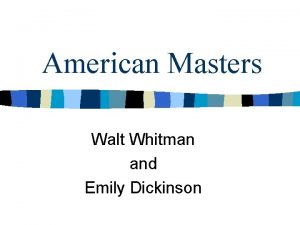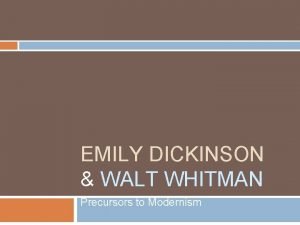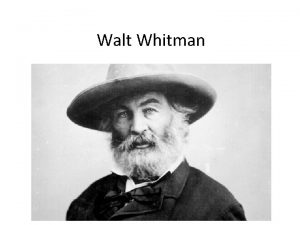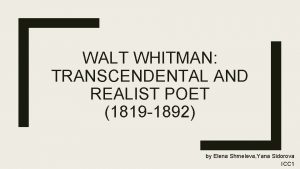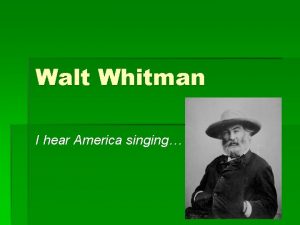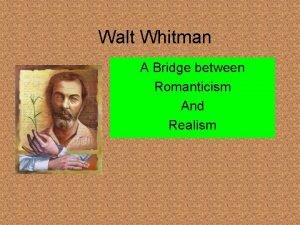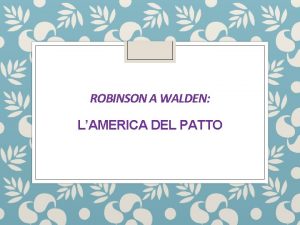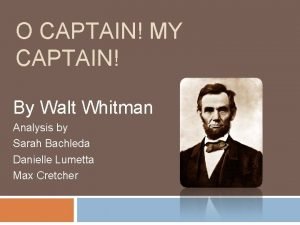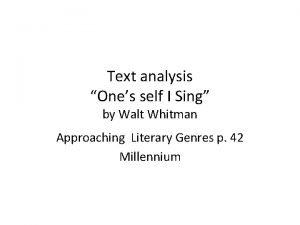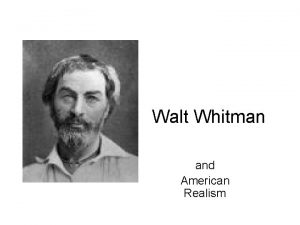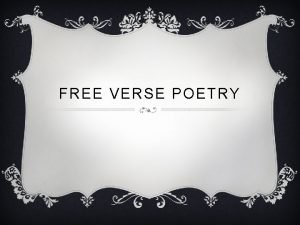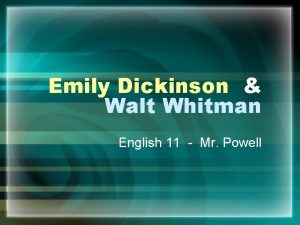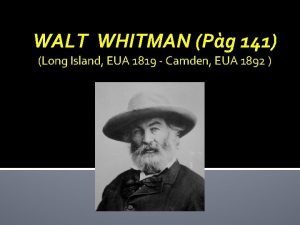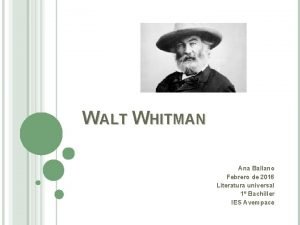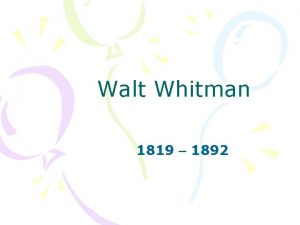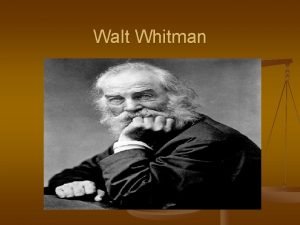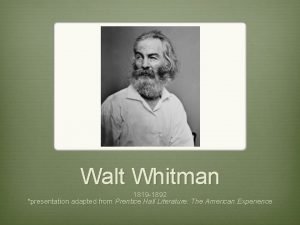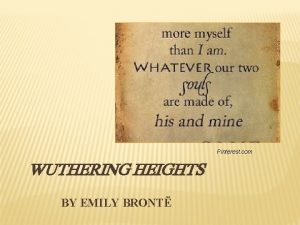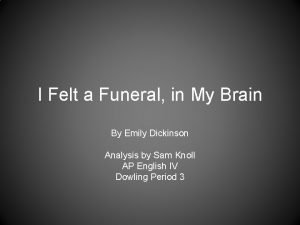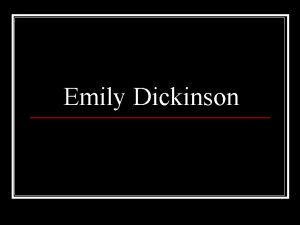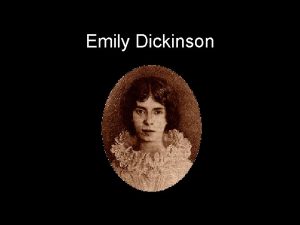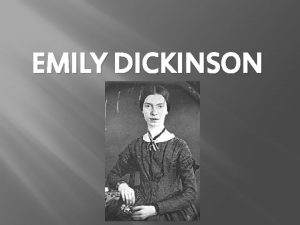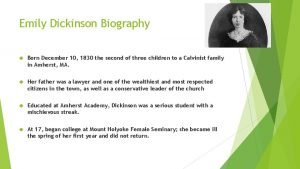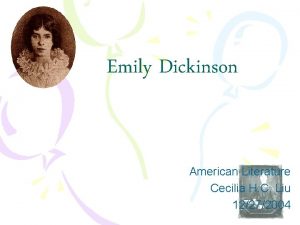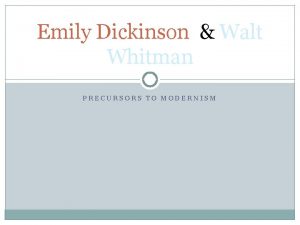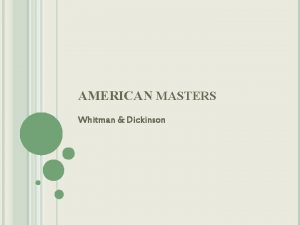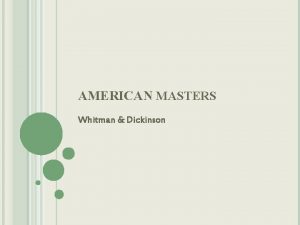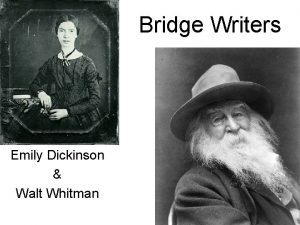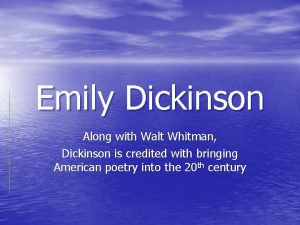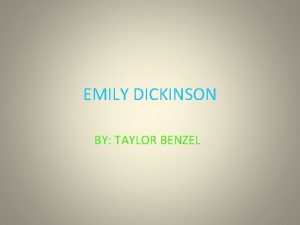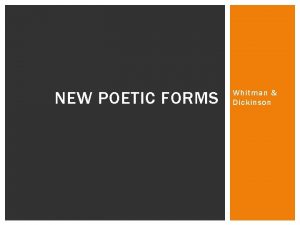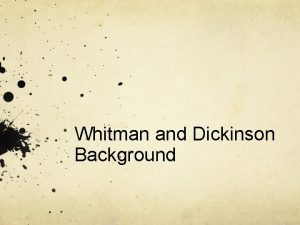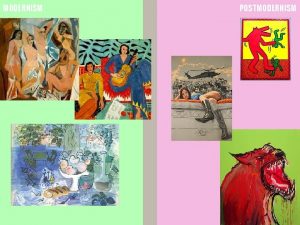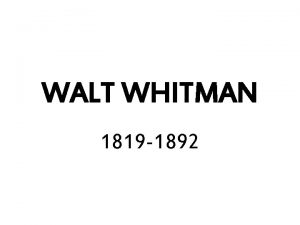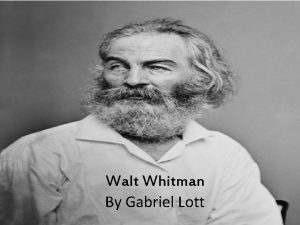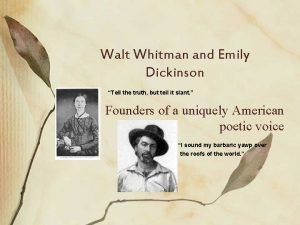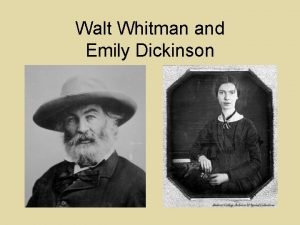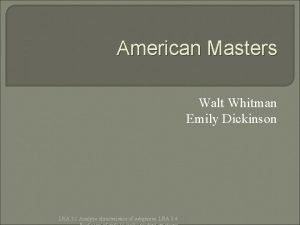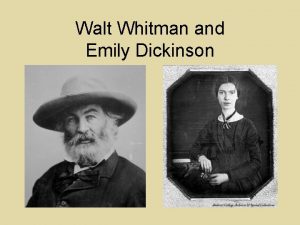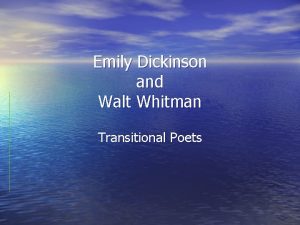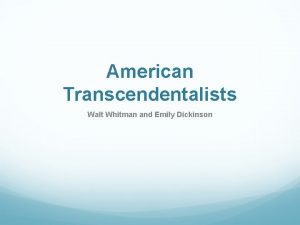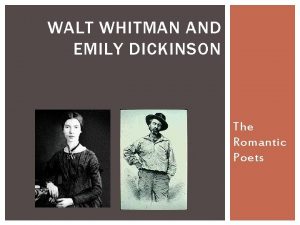EMILY DICKINSON WALT WHITMAN Precursors to Modernism Two



























- Slides: 27

EMILY DICKINSON & WALT WHITMAN Precursors to Modernism

Two Transitional Writers

Walt Whitman • • Whitman may have changed the course of poetry more than any other single person. Almost single handedly, he invented free verse, the poetry of no rhythm and rhyme that had dominated the last century.

Whitman • • Walt Whitman was born in 1819, about half way between the American Revolution and the American Civil War. By 1855, when Whitman published his first edition of poetry, America had changed dramatically. Whitman is the first poet that seemed to speak for all of the new United States.

Diversity • • It was America’s diversity that fascinated Whitman. He saw America as the greatest nation that ever was, and it was great because it was a “melting pot” of skilled, hard-working people from everywhere in the world.

The Young Walt Whitman • • • Before becoming a poet, Whitman held a variety of jobs and lived a kind of vagabond lifestyle. He was very poor as a child and started having odd jobs as a teenager and young man. He was a carpenter, a printer, a journalist, and even was a schoolteacher.

The Poet When he turned to writing poetry, Whitman had already lived a fuller life than many people live in a lifetime. But his poetry was different—very different He saw poetry as organic—growing naturally like flowers and other plants grow. He invented what is now called Free Verse — poetry that has no regular rhythm or rhyme.

A Little Unusual • Most people who saw Whitman’s poetry found it too weird, and many would not even consider it poetry.

Leaves of Grass • • His first book of poems was entitled “Leaves of Grass. ” (1855) Whitman paid for it entirely by himself because publishers thought they were too odd to take a costly chance on. As a former printer, he saved more money by doing the typesetting. He sent a free copy to Ralph Waldo Emerson.

Support from an unusual source • • Emerson was considered America’s greatest thinker and was an unlikely person to back Whitman’s new style of poetry. Yet Emerson was entranced by the poems and responded with a five-page reply. It became the most famous piece of literary sponsorship in American history. Emerson’s support then caused others to rethink and revisit Whitman’s poems.

Emerson’s reply included the following lines: “I greet you at the beginning of a great career, which yet must have had a long foreground somewhere for such a start. Emerson probably didn’t care much about knowing about Whitman’s long foreground, but he was right in assuming Whitman had lived a full and diverse life.

Free Verse • • • Free verse is Whitman's expression of the democratic concepts of a vast diverse America "What we call poems. " he wrote, "are merely pictures. " The "real poems, " he insisted, "are the men and women in all the variety of human experience. "

Leaves of Grass (again and again) • • • Whitman republished Leaves of Grass nine times. Each time, it grew larger with the addition of more poems. In many ways, as he put it, "The United States themselves are essentially the greatest poem. " The volumes are a tribute to the country and to its people, especially the common working people.

Sex • • • Whitman, incidentally, virtually invented sexuality as a subject of American literature (even though Europeans had discovered it centuries earlier). After Whitman, sex became an acceptable subject in American literature. Whitman was also open with his own homosexuality —a bold move for the time.

Abraham Lincoln • • Whitman was also a great admirer of Lincoln's death evoked a strong response in Whitman who wrote several poems about Lincoln’s death. "O Captain, My Captain" is perhaps the best known. "When Lilacs Last in the Dooryard Bloom'd, " is also a well-known Lincoln memorial.

“The Poet of the Inner-Soul” Emily Dickinson was born in 1830 and is considered one of the greatest poets of all time. Like many authors, Dickinson was not known until after her death in 1886. She was, in fact, a very reclusive and quiet woman who hardly ever left her home town.

Fun Fact Emily was educated at Amherst Academy which had started taking female students two years before she enrolled. The she entered Mount Holyoke Female Seminary. The founder, Mary Lyon, ranked students of the basis of those who would receive God’s grace, those who had some hope, and those who had no hope at all. She placed Emily in the last category.

Her Own Religion Not having “conventional” religious views may have also contributed to Emily’s isolation. She refused to sign an oath to dedicate her life to Jesus Christ and she dropped out of school. Even so, she clearly had a belief in God and heaven, but it was different than the views held by her peers.

Emily’s Home in Amherst, Massachusetts

The back of the Dickinson Homestead showing the lawn and garden.

Her Poetry Emily probably wanted to have her poems published but on her own terms, and it seemed that publishers were unwilling to take a risk with them—they were very unconventional at the time. Thomas Wentworth Higginson, editor of The Atlantic Monthly, thought that Walt Whitman influenced her poems, but she said that she never read his poetry because she heard his poetry was “disgraceful. ”

Her Own Style It seems that Emily invented her own style for her poems. They have a sing-song quality and are similar, in many ways, to the old ballads of the English and Irish people. They often alternate between iambic tetrameter and iambic trimeter. Ballad Stanza: ABCB Rhyme Scheme Use of slant rhyme, irregular punctuation, capitalization, etc. .

Key Elements of Dickinson’s Writing Strong images and metaphors enliven her work Explorations of abstract concepts, such as truth and the soul, reveal profound insights Personified concepts, like death and nature, add personality to the work Unusual points of view provide a unique voice Reflections on tiny details reveal great life in the smallest of things Unconventional use of rhyme and punctuation creates subtle effects

Her “Letters to the World” Without a publisher, Emily kept on writing her poetry privately. In one poems she calls them “my letters to the world which never wrote to me. ” She tied them up in little blue ribbons and hid them away in drawers and boxes.

Emily’s Death in 1886 When Emily died, her sister Lavinia was in charge of Emily’s estate. Lavinia knew that Emily wrote some poems, but imagine her surprise when she started going through Emily’s stuff.

Surprise! At first, Lavinia went through boxes and dressers and found about 900 poems. But she kept finding even more. Eventually the total swelled to over 1800 poems. Because of arguments amongst family members, not all of them were published until 1955, nearly seventy years after her death.

Emily’s Legacy Emily Dickinson is now considered one of the greatest American poets. Moreover, she is America’s first major female poet and one of the first major female writers in all of Western literature. Her “letters to the world” have finally found their audience.
 Similarities between walt whitman and emily dickinson
Similarities between walt whitman and emily dickinson Emily dickinson modernism
Emily dickinson modernism Breakout plan
Breakout plan Walt whitman transcendentalism
Walt whitman transcendentalism Whitman transcendentalism
Whitman transcendentalism Walt whitman's, i hear america singing, celebrates
Walt whitman's, i hear america singing, celebrates Walt whitman realism
Walt whitman realism Andai nei boschi walt whitman testo
Andai nei boschi walt whitman testo O captain my captain imagery
O captain my captain imagery Poem animals class 10
Poem animals class 10 One's self i sing analysis line by line
One's self i sing analysis line by line Walt whitman bio
Walt whitman bio Walt whitman photography
Walt whitman photography Walt whitman happiness not in another place
Walt whitman happiness not in another place Walt whitman free verse poems
Walt whitman free verse poems Walt whitman english
Walt whitman english Walt whitman house long island
Walt whitman house long island Walt whitman biografia
Walt whitman biografia Walt whitman born in new york in 1819
Walt whitman born in new york in 1819 Walt whitman biografia
Walt whitman biografia Whitman style
Whitman style Dickinson family tree
Dickinson family tree Emily dickinson i felt a funeral in my brain analysis
Emily dickinson i felt a funeral in my brain analysis Emily dickinson facts
Emily dickinson facts Emily dickinson father
Emily dickinson father What was emily dickinson's childhood like
What was emily dickinson's childhood like Where was emily dickinson born
Where was emily dickinson born Emily norcross dickinson
Emily norcross dickinson
